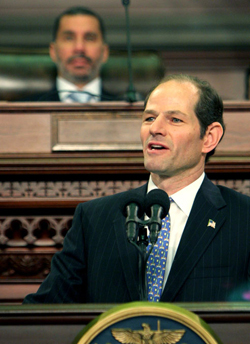Governor Spitzer Proposes Major Education Policy and Funding Reforms
Calls
for full accountability, a comprehensive plan, and a total revision of the school
funding formula
Eliot
Spitzer has proposed an overhaul of the state’s education finance system that
will tie far-reaching accountability reforms to the “the largest infusion of
resources” in state history and change the entire funding formula in a way that
aligns dollars with the needs of children.
In
releasing his first executive budget on January 31, the Governor announced his
historic aid increase for New York’s schools. The courts in the Campaign for
Fiscal Equity (CFE) case have established a $2 billion minimum increase just
for
“We
applaud Governor Spitzer for proposing the most comprehensive school funding
accountability system ever seen in New York State. The courts in the CFE case
were firm that real accountability must accompany any increase in funding. This
proposal is a big step toward compliance with the CFE mandate,” said Michael A. Rebell, executive director of The Campaign for
Educational Equity and former counsel for the plaintiffs in the CFE case.
The
Spitzer camp is calling its set of reforms a “contract” with districts. In
exchange for truly adequate funding, districts receiving major sums ($15
million more or a 10 percent increase over the previous year) are required to
develop a comprehensive plan for how they will direct their funding and
implement their educational programs. As Spitzer explained, “The Federal No
Child Left Behind Act sadly demonstrated that accountability without resources
is a false promise. But we also know that resources without accountability are
a recipe for waste.”
Spitzer
urged investing dollars in programs and strategies that are proven to work,
such as reducing class sizes and improving the quality of teaching, and said
each district will have to select from “a menu of approved strategies and
initiatives.” Under the plan, districts will also have to produce real measures
of performance improvement to evaluate success. The comprehensive plan will
come out of a public process that will involve every education stakeholder in
the district.
A
landmark piece of Spitzer’s address was his calls for a new “foundation”
funding formula that will ensure education dollars match the actual needs of
schoolchildren, not the needs of politicians. The state’s current formulas have
been notoriously subject to political manipulation. Spitzer seeks to replace
these “byzantine and politically driven school aid formulas that are annually
manipulated to produce predetermined results” with a “more efficient,
transparent, and reform-minded” school aid formula.
“Rhetoric
has been flying around for years to fix the state’s arcane and unfair funding
formulas, but Spitzer has put a real proposal on the table to actually do it
with a foundation formula that offers a fair and simplified way to distribute
dollars,” Rebell said.
Spitzer
also proposed to establish universal access to high-quality pre-kindergarten
programs within the next four years.
While
it is difficult to predict what may emerge from the legislative process come
April, “A Contract for Excellence,” at least in theory, holds the potential to
meet each aspect of the highest court ruling in the CFE case—adequate funding
distributed based on actual student need plus rigorous accountability.
Published Thursday, Feb. 1, 2007
